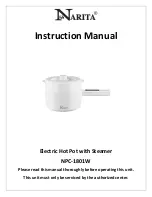
40
X - Roasting styles overview
This section contains a brief explanation of the various roasts you can achieve with the Hottop Cof-
fee Roaster, and will give you a general idea of how roast level affects taste. There are numerous factors
that affect the roast level at a given time or Program setting on the machine. These can include bean age,
moisture level, bean size, line voltage fluctuations, and many more. At some roast levels as little as thirty
seconds or even less can have a big effect on taste. Because of that use the following suggestions as starting
places only. The best guide to preferred roast level is your taste!
Many people think that very dark roasted coffee is the best way to roast, or that coffee has to be
roasted until it is oily to be good for espresso, but that is just not true. As mentioned before, for some brew-
ing methods, a light roast retains more of the delicate flavors, and can give the coffee a wonderful taste that
many people never get a chance to enjoy. Experiment and you will discover what you like best.
Cracks, Flavors and Roast Styles
Before first crack occurs, the coffee will often taste grassy, and can be very sour. You can find this out
for yourself by light-roasting one batch to this extreme and tasting it. Coffee roasted this light has a hard,
acidic bite that reminds one of sour citrus fruit. In the extremes, think grapefruit and you will not be very
far off. Coffee roasted this light is usually not very agreeable to the majority of coffee drinkers. Up to this
point most of the roasting time has been spent removing excess moisture from the beans.
The beginning of first crack is the time when the coffee is just entering the state where it becomes
drinkable. The coffee will be crisp, and acidic - like a very dry wine. This roast style is generally called
“Cinnamon”. Some coffees can be very nice when roasted this way, but most people prefer a roast that is
a little darker when the coffee has a more developed flavor.
Between the time just at the end of first crack, and shortly before second crack begins, the taste-
features of most coffees will be most prominent. Depending on the coffee, these natural flavours can be
remarkable and probably unlike what you have ever tasted. The taste will be predominantly “coffee,” but
behind that you can find hints of fruit, spice, chocolate, nuts, and in some varieties a pleasant leathery or
oaky taste. This style of roast is often referred to as “city roast,” and is generally appreciated by a majority
of coffee drinkers. It is quite suitable for drip coffee or press pot. Some “City” roasted coffees can also
make a very nice espresso, or be used for siphon or vacuum brewers.
A “City” roast is one of the more difficult to achieve because you have to predict when second crack
will occur and stop the roast somewhat before that point. With experience, and by keeping a detailed
“roasting log,” you will learn to anticipate this point using the various tools and techniques discussed in
this manual (sound, smell, appearance, and time). The temperature display of the Hottop Coffee Roaster
will assist in finding that point (refer to page 19). The beginning of second crack is sometimes referred to
as “City Plus.”
As the roast progresses into second crack, the acidity gradually lessens, while at the same time the
body of the coffee becomes heavier. The natural flavors of the coffee beans are reduced in strength, but the
coffee gains in sweetness. Coffee that is roasted about fifteen snaps into second crack is generally referred
to as “Full City”. This is the style that most people prefer for siphon brewers, and espresso. The taste is
very well balanced between acidic and bitter, natural flavors are retained, and the body makes for a very
pleasant beverage. You may notice that a few of the beans have small spots of oil on them when they drop
into the cooling tray, but these often disappear as the beans cool.
As you roast further into second crack and the surface becomes shiny, the coffee will obtain a dis-
tinctly bittersweet taste. This is often referred to as a “Viennese roast”, and some people like this for a
cappuccino since the flavor cuts through milk quite effectively.
CAUTION
: Be careful when you are roasting the beans this dark. Ten or fifteen seconds in roast time
at this point can have a significant and dramatic affect on the taste of the coffee, and thirty extra seconds
in this phase can easily be the difference between good coffee and a beverage that tastes burnt– a very
unpleasant coffee taste.
The “Viennese” style is as dark as most people enjoy their coffee. As you become more proficient
at roasting you may want to experiment and roast coffee this dark, or even a little darker. If you do, you









































